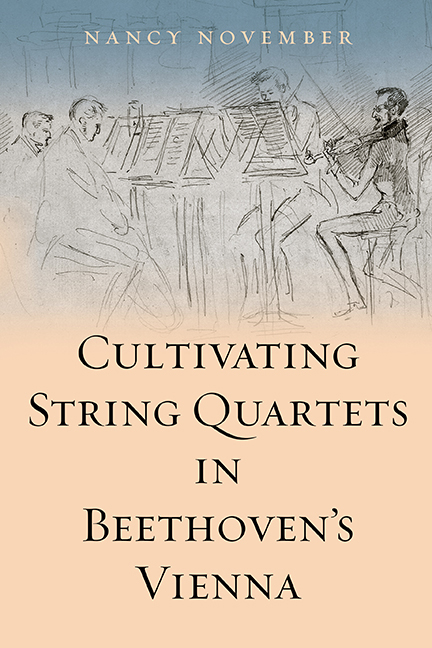Book contents
- Frontmatter
- Contents
- List of Illustrations
- List of Musical Examples
- Acknowledgements
- Introduction
- 1 Defining Chamber Music in the Early Nineteenth Century
- 2 Celebrating Haydn, Cultivating Opera
- 3 Selling String Quartets in Beethoven's Vienna
- 4 Locating String Quartets in Beethoven's Vienna
- 5 Early Nineteenth-Century Performance and Criticism
- 6 Sociability, Showmanship, and Study: ‘Quartet Friends’
- 7 The String Quartet and the Listener
- 8 Schubert's Song, Beethoven's Theatricality
- Epilogue: Constructing ‘Viennese Chamber Music’
- Bibliography
- Index
Epilogue: Constructing ‘Viennese Chamber Music’
Published online by Cambridge University Press: 16 May 2018
- Frontmatter
- Contents
- List of Illustrations
- List of Musical Examples
- Acknowledgements
- Introduction
- 1 Defining Chamber Music in the Early Nineteenth Century
- 2 Celebrating Haydn, Cultivating Opera
- 3 Selling String Quartets in Beethoven's Vienna
- 4 Locating String Quartets in Beethoven's Vienna
- 5 Early Nineteenth-Century Performance and Criticism
- 6 Sociability, Showmanship, and Study: ‘Quartet Friends’
- 7 The String Quartet and the Listener
- 8 Schubert's Song, Beethoven's Theatricality
- Epilogue: Constructing ‘Viennese Chamber Music’
- Bibliography
- Index
Summary
The preceding chapters have often dealt in dualities as I have charted changing conceptions of the string quartet in Beethoven's era. Dualities are found in the publishing history, performance dimension, locations, and listening history, as well as in the compositions themselves. On the one hand, we have seen that in Beethoven's era the string quartet was still considered as chamber music in the eighteenth-century sense: music essentially for and often by performers, which is flexible (possibly originating from or giving rise to arrangement) and ‘open’ (to excision or repetition of movements, for example). Under this view, the string quartet's primary function is to promote entertainment and sociability in private settings. On the other hand, the string quartet was increasingly considered a distinct, elevated, and exemplary genre of music. String quartets were increasingly considered as ‘closed’ musical works, located essentially in the composers’ scores, which demanded detailed study and attention – indeed reverence and respect – from performers and listeners. Under this view the genre was less functional, more representational: string quartets were publicly discussed and idealised, largely by upper-middle-class men, providing them with a sense of cultural identity, heritage, and ownership.
When Beethoven arrived in Vienna, the rage for string quartets was related to the flexibility of the medium and the opportunities for sociability that it engendered. The string quartets that were composed around 1800 were directed to performance in private and semi-private settings, and the enjoyment and interaction of the performers and listeners was primary. String quartets were one of the most popular media for arrangements, permitting further means of sociability, education, and entertainment in the private sphere: arrangements of sentimental operas, for example, allowed both performers and listeners to understand and enact contemporary ideas such as sympathy and the rewarding of virtue. These quartets were highly popular, but they took their place alongside numerous other genres of chamber music, notably Harmoniemusik and works that mixed keyboard, winds, and strings.
A more idealised view of the quartet, and more public roles for the genre, were emerging slowly in Beethoven's era, thanks especially to influential Viennese composers, critics, performers, and publishers, including Beethoven himself. The popularity of string quartets helped with the development of printing technology and print culture in Vienna in particular, which would ultimately promote the score-centred conception of chamber music.
- Type
- Chapter
- Information
- Cultivating String Quartets in Beethoven's Vienna , pp. 222 - 232Publisher: Boydell & BrewerPrint publication year: 2017

